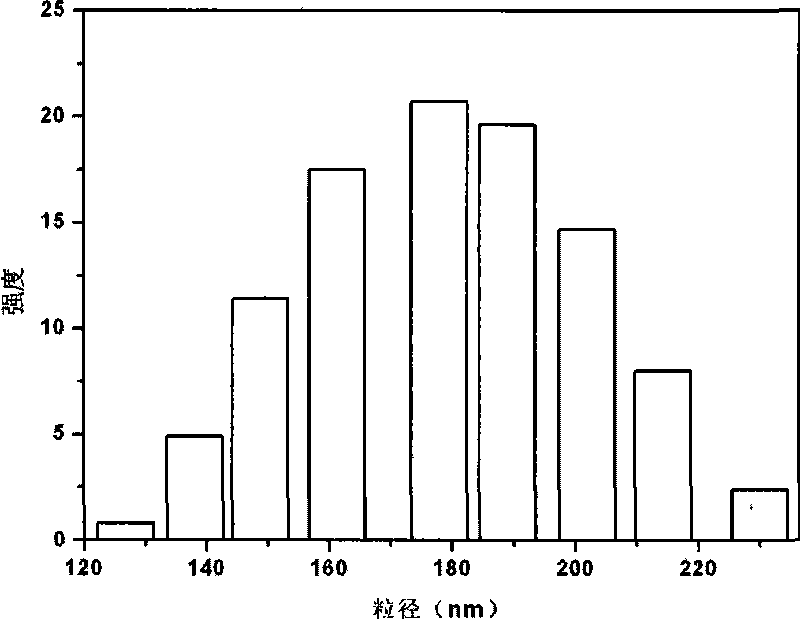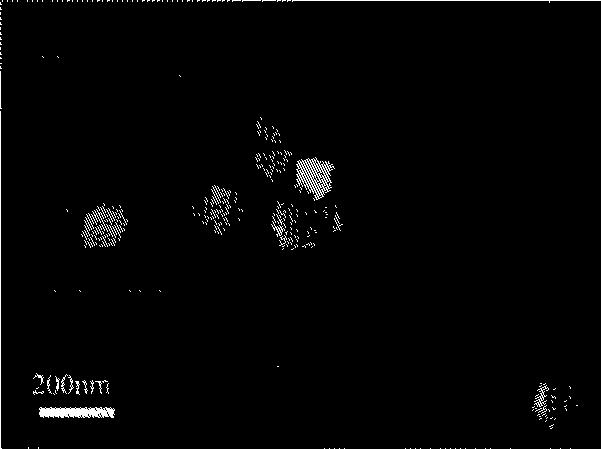Synthetic method of decahedron nanogold
A synthesis method and nano-gold technology, applied in the field of nano-gold, can solve the problems of low yield, non-uniform particle size of decahedral nano-gold particles, complex synthesis steps, etc., and achieve easy separation, simple operation, and particle size. Narrow distribution of effects
- Summary
- Abstract
- Description
- Claims
- Application Information
AI Technical Summary
Problems solved by technology
Method used
Image
Examples
Embodiment 1
[0026] 1) Take 0.277g polyvinylpyrrolidone, dissolve it in 20mL N, N'-dimethylamide, stir evenly, the molecular weight of polyvinylpyrrolidone is 8000.
[0027] 2) Add the chloroauric acid solution and stir at room temperature for 10 minutes to obtain a reaction precursor solution. The concentration of chloroauric acid is 0.01M in molar ratio, and the ratio of polyvinylpyrrolidone: chloroauric acid is 100:1.
[0028] 3) Pour the reaction precursor solution into a microwave reaction tank, and put it into a microwave reactor, the reaction temperature is 150° C., and the reaction time is 30 minutes.
[0029] 4) The reaction system was naturally cooled to room temperature. Centrifuge at a rotational speed of 3000 rpm to separate the synthesized gold nanoparticles from polyvinylpyrrolidone, and then wash with absolute ethanol for 3 times. The particle size of the obtained decahedral gold nanoparticles is about 180nm.
Embodiment 2
[0031] 1) Take 0.277g polyvinylpyrrolidone, dissolve it in 23mL N, N'-dimethylamide, stir well, the molecular weight of polyvinylpyrrolidone is 20000.
[0032] 2) Add chloroauric acid solution and stir at room temperature for 10 minutes to obtain a reaction precursor solution. The concentration of chloroauric acid is 0.001M in molar ratio, and the ratio of polyvinylpyrrolidone: chloroauric acid is 50:1.
[0033] 3) Pour the reaction precursor solution into a microwave reaction tank, and put it into a microwave reactor, the reaction temperature is 200° C., and the reaction time is 1 min.
[0034] 4) The reaction system was naturally cooled to room temperature. Centrifuge at a rotational speed of 2500 rpm to separate the synthesized gold nanoparticles from polyvinylpyrrolidone, and then wash with deionized water for 3 times. The particle size of the obtained decahedral gold nanoparticles is about 180nm.
Embodiment 3
[0036] 1) Take 0.277g polyvinylpyrrolidone, dissolve it in 24.5mL N, N'-dimethylamide, stir evenly, the molecular weight of polyvinylpyrrolidone is 63000.
[0037] 2) Add the chloroauric acid solution and stir at room temperature for 10 minutes to obtain a reaction precursor solution. The concentration of chloroauric acid is 0.05M in molar ratio, and the ratio of polyvinylpyrrolidone: chloroauric acid is 500:1.
[0038] 3) Pour the reaction precursor solution into a microwave reaction tank, and put it into a microwave reactor, the reaction temperature is 100° C., and the reaction time is 60 minutes.
[0039] 4) The reaction system was naturally cooled to room temperature. Centrifuge at a rotational speed of 3500 rpm to separate the synthesized gold nanoparticles from polyvinylpyrrolidone, and then wash with acetone for 3 times. The particle size of the obtained decahedral gold nanoparticles is about 100 nm.
PUM
| Property | Measurement | Unit |
|---|---|---|
| particle diameter | aaaaa | aaaaa |
| particle diameter | aaaaa | aaaaa |
Abstract
Description
Claims
Application Information
 Login to View More
Login to View More - R&D
- Intellectual Property
- Life Sciences
- Materials
- Tech Scout
- Unparalleled Data Quality
- Higher Quality Content
- 60% Fewer Hallucinations
Browse by: Latest US Patents, China's latest patents, Technical Efficacy Thesaurus, Application Domain, Technology Topic, Popular Technical Reports.
© 2025 PatSnap. All rights reserved.Legal|Privacy policy|Modern Slavery Act Transparency Statement|Sitemap|About US| Contact US: help@patsnap.com



